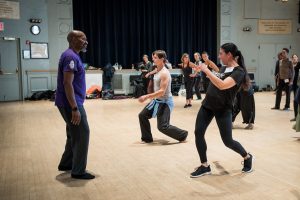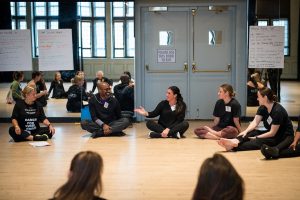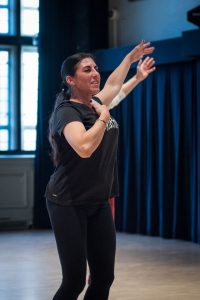Ronald K. Brown + DEL: Making Dances
A Reflection by Patricia Profita
 What an incredible second day! Beginning the class with a discussion about religion and spirituality made me reflect on my own teaching practice. By engaging in an open and honest conversation with our peers, we were able to truly understand and reflect on ourselves, as well as connect with others. For me, it reaffirmed that teachers very often take for granted that students understand the topic or concept that is being presented. We had to first define religion and spirituality before providing examples and connections. This will prove very helpful with my own students, many of whom come from different cultural backgrounds. Having students explain something in the words of a peer will make the idea more concrete and attainable to them. Only when they understand something can they truly discuss and connect to it.
What an incredible second day! Beginning the class with a discussion about religion and spirituality made me reflect on my own teaching practice. By engaging in an open and honest conversation with our peers, we were able to truly understand and reflect on ourselves, as well as connect with others. For me, it reaffirmed that teachers very often take for granted that students understand the topic or concept that is being presented. We had to first define religion and spirituality before providing examples and connections. This will prove very helpful with my own students, many of whom come from different cultural backgrounds. Having students explain something in the words of a peer will make the idea more concrete and attainable to them. Only when they understand something can they truly discuss and connect to it.
The warm-up built upon the idea, as Ron said, of first being strong on our own before having strength to support others. Hence, beginning on the floor and working our way up was a great metaphor for life that I will present to my students. The complexity of the movements progressed, and each was broken down into its basic parts in order to allow entry points for all participants. This was the perfect example of dance for every child (and adult!)
I truly enjoyed today’s choreography! Once again, Ron scaffolded the movements and before we knew it, we were dancing! I love the fact that he not only scaffolded within the lesson, but within the workshop! By incorporating what we did yesterday, he provided continuity as he built towards the final product. Being a part of this process reminded me that there should be continuity and scaffolding not only within my own lessons, but within my units. This will allow all of my students to climb the ladder of success rung by rung.
 Dancing our own stories was a brilliant way to have us look within ourselves and then express to others. The most successful choreographers begin with improvisation and what is important to them, not just the music and the counts. By allowing us to scribe with a partner, he gave us someone to work with to achieve solo success. Having to perform the sequence more than once made it more definitive and developed it from improvisation into choreography, and made it more natural. I have often allowed my students to choose their own musical accompaniment. How creative for Ron to select the accompaniment himself! Watching each presentation with the chosen music enhanced each individual’s story. What I learned from this was twofold- The process from reflection and thoughts to words, movements, and then finally a dance was completed, and it was a gift that was handed to us at the end of an incredible journey. What stood out even more was the connection that Ron had with his students- he had to be extremely attuned to them in order to understand the movements of each and so accurately find the perfect medium with which to communicate the individual message. This demonstrates what I commented on in class- Ron began his workshop by setting a tone of respect and came full circle, for only in an environment of respect would we feel comfortable enough to expose our innermost thoughts in a way that he could receive them so perfectly.
Dancing our own stories was a brilliant way to have us look within ourselves and then express to others. The most successful choreographers begin with improvisation and what is important to them, not just the music and the counts. By allowing us to scribe with a partner, he gave us someone to work with to achieve solo success. Having to perform the sequence more than once made it more definitive and developed it from improvisation into choreography, and made it more natural. I have often allowed my students to choose their own musical accompaniment. How creative for Ron to select the accompaniment himself! Watching each presentation with the chosen music enhanced each individual’s story. What I learned from this was twofold- The process from reflection and thoughts to words, movements, and then finally a dance was completed, and it was a gift that was handed to us at the end of an incredible journey. What stood out even more was the connection that Ron had with his students- he had to be extremely attuned to them in order to understand the movements of each and so accurately find the perfect medium with which to communicate the individual message. This demonstrates what I commented on in class- Ron began his workshop by setting a tone of respect and came full circle, for only in an environment of respect would we feel comfortable enough to expose our innermost thoughts in a way that he could receive them so perfectly.
This exercise is something that I would love to try with all of my students! All too often, students are afraid because they feel that they will not be “right”. However, my story radiated from me. It was not taught to me. As a result, my students would be able to understand what I felt… there was no right or wrong… there was just me.
From Deb, the list of what I have learned is endless! I love the way that she made me realize this lesson could be tailored to any grade, even the youngest, by providing words or emotions to “act out”. Providing three simple motifs for feelings is a way to reach younger students. The process of going from the concrete to the more abstract can begin at a younger age. I also love that she offered a way to assess something so personal. Most teachers only assess the product, but as Deb suggested, a well-defined rubric with clear process guidelines can allow us to assess students in a more complete way. Again, this will bring dance to every child.
 I learned so much more from Deb than just “teaching methods” (which, by the way, are fabulous!) during this workshop. She modeled what a gifted teacher looks like. Every technique, strategy, and process that Ron demonstrated was supplemented with real-life examples and ides for ALL grades/ learners. The variations she provided offered endless possibilities for both new and seasoned teachers to reach all students. More importantly, Deb demonstrated that a teacher is always a student- whether it was joining as a partner in the personal story task or learning the choreography and partaking in the warm-up. She proved that the best teachers are the most engaged learners.
I learned so much more from Deb than just “teaching methods” (which, by the way, are fabulous!) during this workshop. She modeled what a gifted teacher looks like. Every technique, strategy, and process that Ron demonstrated was supplemented with real-life examples and ides for ALL grades/ learners. The variations she provided offered endless possibilities for both new and seasoned teachers to reach all students. More importantly, Deb demonstrated that a teacher is always a student- whether it was joining as a partner in the personal story task or learning the choreography and partaking in the warm-up. She proved that the best teachers are the most engaged learners.
